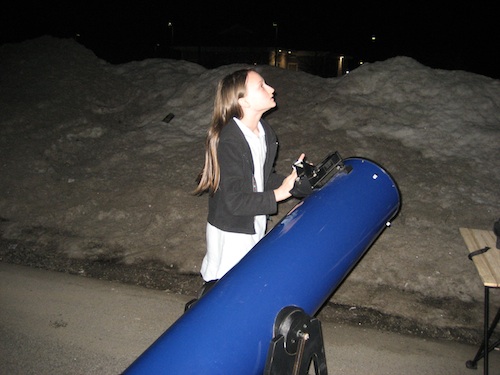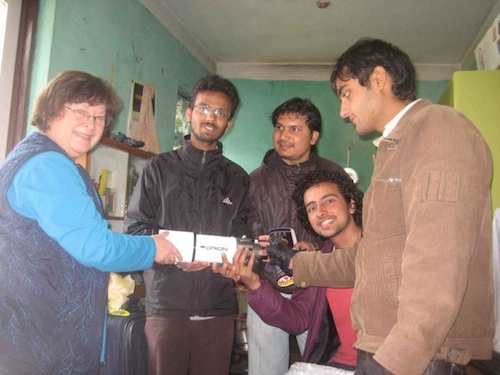GAM 2012 Blog
|
April 29 By Joan Chamberlin |
Back to the GAM Blog |  |
| Hello, friends. My name is Joan Chamberlin, and I am an amateur astronomer, astronomy educator, and NASA JPL Solar System Ambassador for the state of Maine in the USA. |
||
I am a retired special education teacher, who became involved in astronomy about 10 years ago mostly because I was interested in observing all the beautiful objects to be seen in the night sky with the naked eye and with telescopes. As soon as I learned how to use a telescope and began attending star parties with my friends at two different astronomy clubs, I realized that what I loved most of all was sharing my knowledge with schools and the public.
The best thing about this telescope is that it is easy to set up and, because it gathers lots of light, it gives marvelous views of deep sky objects such as globular clusters, open clusters, galaxies, and planetary nebulae. It is also great for viewing the moon and planets.
My outreach events are at parks, supermarket parking lots, schools, nature reserves, campgrounds, and the club observatory. One of the questions I often am asked when showing kids the night sky is “Can we see the flag on the moon in this telescope? Of course the flag is much too small, and we are much too far away to see it. Even the Hubble Space Telescope is not able to see something that small.

Here is a picture of a girl looking through my telescope at the moon
from a parking lot at a local supermarket. Credit : Joan Chamberlin
I go into schools to teach students basic astronomy concepts and to explain NASA robotic missions. I use resources from the NASA Night Sky Network, which supports over 350 astronomy clubs throughout our country. Although it was developed for US clubs, people from around the world are welcome to go to the website and download the power points, hands on activities, and other materials for teaching astronomy at no charge. Recently I went to Nepal, where I gave a presentation about how to access these resources. http://nightsky.jpl.nasa.gov/download-search.cfm
Another outreach program that I do for schools and youth groups is called Globe at Night, a program that teaches about light pollution and how to battle this worldwide problem. This is a program that is simple to do and requires no special equipment. The instructions for doing it are right on the website, and participants can put data from their own location into the common data base to help make a global map of the light pollution around the world. http://www.globeatnight.org/

Here is a picture of me showing students the best kind of lighting to prevent light pollution.
This was at the Celebration Co-Ed School in Kathmandu, Nepal. Credit : Joan Chamberlin
I belong to an organization called Astronomers Without Borders, which is trying to connect people around the world through astronomy events. For me, this has been a very satisfying organization to be involved with. I have shared resources and friendship with people in Asia, Africa, and South America. Some of these people I have had the pleasure to meet in person and even to visit and do astronomy events with. http://www.astronomerswithoutborders.org/

Here is a picture of me being greeted by members of Nepal Astronomical Society in Kathmandu, Nepal.
I met this group through Astronomers Without Borders. Credit : Joan Chamberlin
I hope that many of you will experience the excitement of the night sky. Keep looking up!
____
This article is a repost and the original article has been published in Astronomi Magazine in Indonesia.
|
|
Joan Chamberlin, an amateur astronomer from Astronomical Society of Northern New England, Kennebunk, Maine, USA & Southern Maine Astronomers, Portland, Maine. She is also NASA JPL Solar System Ambassador for the state of Maine in USA and a retired special education teacher. She is also a member of Astronomers Without Borders. |








